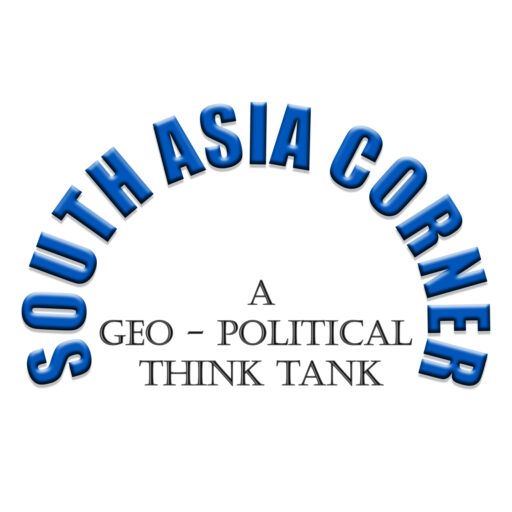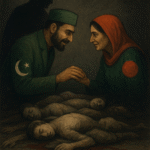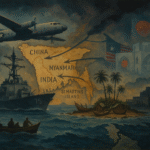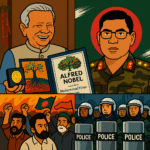In the shifting sands of West Asian geopolitics, the Iran-Israel-US standoff remains one of the most dangerous and ideologically charged fault lines in global diplomacy. It is a slow-burning fuse, shaped not just by military posturing or nuclear ambitions, but by history, theology, and an unyielding clash of civilisations. To understand this complex triangle, one must navigate the labyrinth of Persian legacy, the trauma of revolution, theocratic rigidity, and modern-day realpolitik.
The Ancient Civilisation and the Fall of the Peacock Throne
Iran, the heir to the ancient Persian Empire, once boasted of a civilisational richness rivalled only by Greece, Egypt, and China. From Cyrus the Great to Darius, Persia’s cultural, scientific, and imperial glory was unmatched. However, the 20th century witnessed a brutal truncation of its royal lineage when the last Shah of Iran, Mohammad Reza Pahlavi—an American ally and self-proclaimed moderniser—was deposed in the 1979 Iranian Revolution.
The Shah’s close relationship with the West, his extravagance, and brutal suppression by SAVAK (his secret police), stirred widespread resentment. His forced Westernisation clashed violently with Iran’s deep Shia religious roots. Enter Ruhollah Khomeini, the exiled cleric who returned triumphantly from Paris to spearhead an Islamic revolution and dismantle Iran’s monarchy in favour of a theocracy ruled by the “Vilayat-e-Faqih”—the Guardianship of the Islamic Jurist.
The Siege, the Rise, and the Hatred
Shortly after the revolution, Iranian students loyal to Khomeini stormed the US Embassy in Tehran, taking 52 American diplomats hostage for 444 days. This unprecedented act of aggression severed Iran’s ties with the West and set the tone for decades of mutual hostility. This was no mere diplomatic incident—it was the beginning of Iran’s declared resistance to what it saw as “global arrogance,” with the United States cast as the ‘Great Satan’ and Israel as its ‘Zionist offspring.’
In a symbolic parallel, the Iranian Embassy Siege in London in 1980 by an Iranian Arab separatist group (and its dramatic storming by the British SAS) highlighted how the Iranian revolution’s ripple effects extended even to European capitals. Iran’s internal discontent was now spilling over onto the global stage.
Khomeinism: Ideological Orthodoxy Turned Foreign Policy
Under Imam Khomeini, Iran began exporting its revolutionary ideals. The state-sponsored doctrine was not just about domestic piety, but about regional upheaval—supporting Shia movements from Lebanon to Iraq. Hezbollah became its prized proxy in Lebanon, positioned directly against Israel. Iran’s obsession with Israel is rooted not only in political opposition but in eschatological narratives: the regime’s apocalyptic vision involves Israel’s destruction as a prelude to the return of the Mahdi.
The notion that Iran’s clerics maintain a watchtower or clock in Tehran that counts down to Israel’s destruction is not folklore—it represents a deeply ingrained pathology. In this day and age, such genocidal fantasies are not only morally repugnant but chillingly regressive. To wish for the annihilation of an entire race—a nation with historical traumas of its own, namely the Holocaust—is beyond disturbing. It speaks of a warped ideological worldview completely divorced from the diplomatic norms of the 21st century.
Civil Society Crushed, Democracy Gagged
For over 40 years, Iran has been ruled by an unelected supreme clerical caste. The presidency and parliament exist, but only within the narrow limits approved by the Supreme Leader and the Guardian Council. The Iranian civil society, bursting with young, educated, and often progressive citizens, has been repeatedly silenced through censorship, brutal crackdowns, and prison. Movements like the Green Revolution (2009) and the 2022 protests after Mahsa Amini’s death showed the yearning for freedom. But the regime’s steamroller—the Revolutionary Guards, Basij militias, and clerical orthodoxy—crushed each dissenting wave with relentless brutality.
The truth is stark: Iran has had no genuine democracy in over four decades. Elections are performative. Women’s rights are trampled. Minorities like the Baha’is, Kurds, and Sunni Muslims face systemic persecution. The judiciary serves the clerics, not justice.
Strait of Hormuz, Shatt al-Arab, and the Oil Card
Geography is Iran’s enduring leverage. It straddles the Strait of Hormuz, through which about 20% of the world’s oil passes. Any serious conflict in the Gulf could skyrocket global oil prices, shatter supply chains, and paralyse economies. Iran has long threatened to block the Strait as a retaliatory measure against Western sanctions or Israeli attacks.
The Shatt al-Arab waterway, a source of historic tension with Iraq, remains another flashpoint. Control over these maritime arteries gives Iran immense strategic depth—though always under threat from superior US naval forces.
China, Russia, and the Axis of Opportunity
In the midst of isolation from the West, Iran has leaned toward the East. The Belt and Road Initiative (BRI) with China promises infrastructural and economic lifelines—ports, railways, and energy projects. But Beijing’s support is transactional, not ideological. China does not share Iran’s radical dreams of Israeli extinction; it merely seeks energy security and regional access.
Russia, meanwhile, has become a more willing partner—particularly after 2022. With Putin’s war in Ukraine, Iran and Russia have found common cause in opposing the West. Iran has supplied drones to Russia; in return, Moscow offers diplomatic cover and potential military technology. Yet, even Russia is unlikely to go to war for Iran. Strategic cooperation does not equal mutual defence.
Israel’s Red Lines and US Calculus
Israel, for its part, views a nuclear Iran as an existential threat. For over a decade, Mossad has carried out cyber sabotage (like Stuxnet), assassinations of Iranian nuclear scientists, and precision airstrikes in Syria targeting Iranian assets. Iran’s slow progress toward weapons-grade uranium, despite the JCPOA agreement and its collapse, is a red line that Jerusalem will not tolerate.
The United States, meanwhile, remains trapped in the long shadow of its own mistakes. From the Iraq invasion to the withdrawal from the JCPOA under Trump, American policy has oscillated between coercion and diplomacy with little strategic success. Biden’s administration is caught between reengagement and deterrence, knowing that any Israeli-Iranian war could drag the US into a devastating regional conflict.
The Moral Paradox
It is one thing for states to posture, to defend territory, or contest influence. But Iran’s open celebration of martyrdom, its desire to “wipe Israel off the map,” and its dehumanisation of Jews represent not just political aggression but moral decay. In an era where humanity should be learning from the Holocaust, Rwanda, and Bosnia, Tehran’s rhetoric hearkens to the darkest chapters of our collective past.
How can a nation with such a glorious civilisational heritage—from Rumi to Avicenna—be reduced to a state where nuclear weapons and theological hatred dictate its worldview?
Conclusion: A Volatile Future
The Iran-Israel-US triangle is not just about missiles and militias. It is about identities, ideologies, and irreconcilable visions for the Middle East. Iran’s theocracy, increasingly paranoid and isolated, clings to a messianic dream even as its people suffer under sanctions and repression. Israel, assertive and armed, will not allow Tehran to go nuclear. The US, meanwhile, dances an impossible waltz—deter, sanction, engage, and threaten, all at once.
This standoff may simmer for years, but one miscalculation—one airstrike too far, one assassination too public—could ignite a firestorm. A war no one can win, but all may lose.






